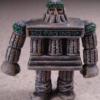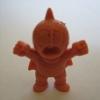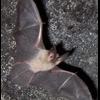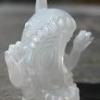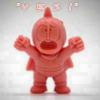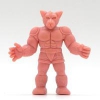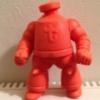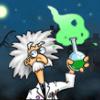Firstly, apologies for resurrecting this thread, and secondly, apologies are due for the length of this post.
I have used hand sanitizer to remove Sharpie marks from sheet-metal and my skin. It works great if the Sharpie is fairly fresh, but not so much on the sheet-metal after a week or so. I'm not sure how it might work on 25-year-old Sharpie marks on M.U.S.C.L.E. figures, but it might be worth a try.
Furthermore, I've done some scale modeling in the past, and that has given me some experience in paint removal. My first step in removing paint from a M.U.S.C.L.E. figure would be a scrubbing with soapy water. If that removes the paint, great! The figure, in that case, was covered with water-based paint, and some elbow grease will have it completely gone.
If the water didn't remove the paint, the next step is 91% isopropyl alcohol or Simple Green. The alcohol will remove alcohol-based acrylic paint very quickly; the paint melts away, rather than flaking or lifting off. Simple Green, in its original undiluted form, is great for removing all but the most persistent enamels, and it is also non-toxic (great for those of us who have kids or pets). It can also be used for its intended purpose: cleaning. If neither Simple Green nor isopropyl alcohol removed the paint, it's onto the most drastic methods.
Warning: I have not tested the following methods, so I do not know how they will affect M.U.S.C.L.E. plastic. They also involve some nasty chemicals that require handling precautions. Use appropriate safety equipment, work in a well-ventilated area, keep away from kids and pets, and proceed at your own risk!The more drastic methods are Westley's Bleche-Wite (used for cleaning whitewall tires), Castrol Super Clean (or equivalent), DOT 3 brake fluid, and oven cleaner. I have used oven cleaner to remove paint from model car parts. While it removed (most of) the paint, and did not adversely affect that particular plastic, I highly ill advise using it. Even the "lemon-scented," "fume-free" stuff gives off a very obnoxious odor that lingers for weeks. These methods are better tried on a test figure, if possible, and then your purple Claw, light blue 23, purple 29, green 189, etc, etc. And don't strip paint from an l.designs custom-painted figure.

If you do try the more drastic methods, I'd like to know how they worked. Hope I've been at least somewhat helpful!
Edit: I repeated the
washing machine experiment with the damaged 220 seen in the last pic of
this post. This time, the results were even more dismal: the figure slid under the agitator, and there was no apparent difference in before and after. So, obviously enough, the washing machine is for textiles,
not M.U.S.C.L.E. figures! That 220 will be taking a trip through the dishwasher shortly, though, and he'll eventually be used as a test shot to see if the advanced paint-removal methods listed above will harm M.U.S.C.L.E. plastic.
Edit part two: Most of the rest of those figures (29 and the damaged 138 excluded) were put in a small jar with warm water and hand soap last night. The soak didn't work as well as I'd hoped (probably because I shook the jar), but most of them look much better after a scrubbing. 151, however, is ink-stained, and 223 still has what appears to be silver paint at his right elbow. For the very dirty ones, such as 110, I squirted a pump of hand soap directly on the dry figure, scrubbed, and rinsed. I've yet to take pictures, but 110's color is now much more similar to the others.'
And yet a third edit: I ran the 220 through the dishwasher last night. Yet again, the results were dismal. No change in the figure's appearance was noted. Perhaps further research is needed, but I am convinced that washing machines and dishwashers are thoroughly unsuitable for cleaning M.U.S.C.L.E. figures.
Edited by Jet-Mech, 10 July 2011 - 12:03 PM.






